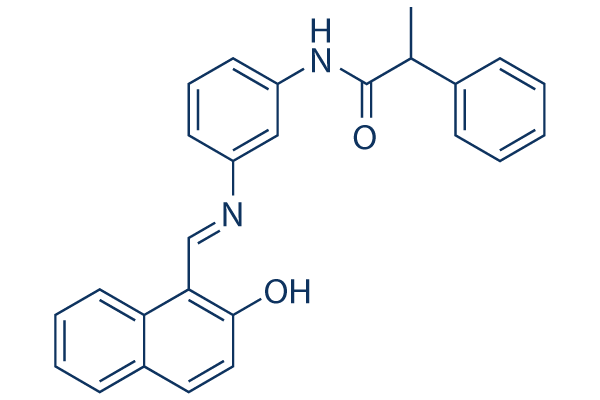All AbMole products are for research use only, cannot be used for human consumption.

In vitro: Salermide prompts tumour-specific cell death in a wide range of human cancer cell lines. The antitumour activity of Salermide is primarily because of a massive induction of apoptosis. Salermide induces apoptosis in cancer but not in normal cells. It induces strong apoptosis without any evident effect on the cell cycle in all the cancer cell lines analysed except in non-tumorigenic MRC5 cells. The induction of apoptosis is cell-type-specific and dose-dependent. In vivo: Salermide is well tolerated by mice at concentrations up to 100 μM. Its feeding does not produce any adverse health effects in mice as monitored by diet consumption, body-weight gain, and postural and behavioural changes.
| Cell Experiment | |
|---|---|
| Cell lines | Cell lines: MOLT4, MDA-MB-231 and SW480 cancer cell lines |
| Preparation method | Cell viability is determined using the 3-(4,5-dimethylthiazol-2-yl)-2,5-diphenyltetrazolium bromide assay as described earlier. IC50 index is calculated using four Salermide concentrations (25, 50, 75 and 100 μm) for 24 h. The percentage of apoptotic cells is determined with the FACSCalibur apparatus. |
| Concentrations | 0, 25, 50, 75 or 100 μM |
| Incubation time | 24 h |
| Animal Experiment | |
|---|---|
| Animal models | Athymic (BALB/c, nu/nu) female nude mice |
| Formulation | |
| Dosages | 100 μl of 100 μM |
| Administration | i.p. |
| Molecular Weight | 394.47 |
| Formula | C26H22N2O2 |
| CAS Number | 1105698-15-4 |
| Form | Solid |
| Solubility (25°C) | 78 mg/mL in DMSO |
| Storage |
Powder -20°C 3 years ; 4°C 2 years In solvent -80°C 6 months ; -20°C 1 month |
| Related Sirtuin Products |
|---|
| SIRT1-IN-1
SIRT1-IN-1 is a selective SIRT1 inhibitor with an IC50 of 0.205 μM. |
| Sirtuin-1 inhibitor 1
Sirtuin-1 inhibitor 1 is an inhibitor of Sirtuin-1 that plays important roles in obesity-induced diabetes and aging-related diseases. |
| ADTL-SA1215
ADTL-SA1215 is a first-in-class, specific small molecule activator of SIRT3 that modulates autophagy in triple-negative breast cancer. |
| SIRT2/6-IN-1
SIRT2/6-IN-1 is a SIRT6/SIRT2 inhibitor, with IC50s of 106 μM and 114 μM. |
| SIRT6-IN-2
SIRT6-IN-2 is a selective SIRT6 inhibitor (IC50: 34 μM). |
All AbMole products are for research use only, cannot be used for human consumption or veterinary use. We do not provide products or services to individuals. Please comply with the intended use and do not use AbMole products for any other purpose.


Products are for research use only. Not for human use. We do not sell to patients.
© Copyright 2010-2024 AbMole BioScience. All Rights Reserved.
